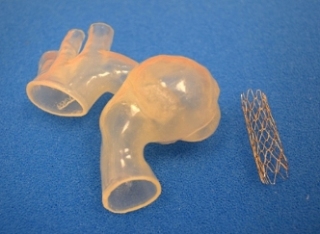Apr 2 2015
17-year-old Ariana Smith has benefited from a novel 3D-printed heart model designed for helping cardiologists to treat a huge, complex aortic aneurysm. She became the first patient in Michigan and the first at the Children's Hospital of Michigan, a part of the Detroit Medical Center (DMC) to benefit from this model.
 Photo courtesy of the Children's Hospital of Michigan DMC
Photo courtesy of the Children's Hospital of Michigan DMC
The mother of Ariana, Jacqueline Foster decided in November, 2014 that her four children should take an electrocardiogram (EKG) test, which helps study problems related to the heart’s electrical activity, as a precautionary measure since one of her sons was suffering from a heart murmur.
Ariana underwent this test and the results suggested that she might have abnormalities in her aorta. She was asked to approach the Children's Hospital of Michigan. Ariana, an active teen, who loves cheerleading and volleyball, first underwent a cardiac catheterization, which is a technique where a tube is positioned in the blood vessel for doctors to suggest a suitable diagnosis and treatment.
The procedure revealed that Ariana was suffering from a large aortic aneurysm with the aorta having a distorted path or shape. This would pose a significant danger to Ariana’s life in the future.
We were devastated to hear this news. Ariana had no symptoms. I understand an aneurysm is considered a silent killer. We hoped and prayed that everything would turn out ok.
Jacqueline Foster - Mother of Ariana
Daisuke Kobayashi, M.D., a cardiologist on staff at the Children's Hospital of Michigan and in charge of Ariana's treatment and care, explained that heart specialists at the hospital began studying the chance of treating Ariana with covered stents in order to make the artery expand to block the aneurysm to prevent it from rupturing.
Ariana's condition was extensively discussed with our pediatric cardiovascular surgeons and cardiologists in order to provide the best treatment and outcome. Surgical therapy was a high-risk operation for her age and anatomy which could lead to possible complications with her aorta.
Daisuke Kobayashi, M.D. - Cardiologist
Children's Hospital of Michigan
The Children's Hospital of Michigan is a part of a research study called the COarctation of the Aorta Stent Trial (COAST II) and is one of the few hospitals in the country taking part in the study. It is approved by the US Food and Drug Administration (FDA), and makes use of stents having a special lining for treating aortic narrowing and aneurysms. After positioning the stent in the aorta, the covering or lining becomes the blood vessel wall and stops the flow of blood into the aneurysm.
Using covered stents can treat both the aneurysm and the obstruction. However, if this procedure is not done properly, it may cause complications.
Since the procedure is so complex, a team of heart specialists on staff including Daisuke Kobayashi, M.D., Richard Humes, M.D., Thomas Forbes, M.D. and Daniel Turner, M.D. collaborated on using a novel tool with the help of computed tomography (CT) to produce 3D-printed models of Ariana's heart.
Materialise, a key supplier of 3D printing software and services, with a local base in Plymouth, Michigan, designed the model. Using its HeartPrint services and Mimics Innovation Suite software, Materialise developed a 3D-printed, life-like model of Ariana’s aorta using her CT scan. As a result, the team was able to accurately plan treatment and practice the intervention before the actual procedure. This allowed the team to determine potential issues they might identify and accurately pinpoint the stent placement.
"At Materialise, we strive to create a better and healthier world and are proud that our software and services were able to help the great team at the Children's Hospital of Michigan to make a positive impact on Ariana's life," said Todd Pietila, Cardiovascular Business Development Manager at Materialise. "It was a tremendous honor to support this case and we look forward to continued collaborations."
According to Dr. Turner, in the case of Ariana, the 3D printed model was essential for more than just problem diagnosis and visualization.
"Using the 3D printed model of Ariana's aorta, we performed a 'practice-run' or simulation in the cath lab, where we actually placed a stent into the model. This allowed us to precisely plan the procedure and see how the stent responded in her unique and tortuous anatomy. Then, when we performed Ariana's actual procedure, we had a good idea of how it was going to go," Dr. Turner said.
In a normal scenario, Ariana’s case would require surgery with an increased risk, higher level of discomfort and a longer stay at the hospital, thus resulting in missing school for a longer duration. By undergoing treatment in the catheterization lab, Ariana spent only one night in hospital and returned home the next day.
"We anticipate that Ariana will not require surgery to treat this condition. Dr. Kobayashi will follow her closely in the office. Most importantly, this experience will allow us to treat future patients more safely with the use of 3D printing technology. This is only the beginning," Dr. Turner said.
Ariana enjoyed pancakes after the procedure, returned home after a day, resumed school in as little as a week, and hopes to soon go shopping for her prom.
"We are so thankful to God and all of the nurses and doctors at the Children's Hospital of Michigan. Ariana is doing great and we would not have had her treatment anywhere else," Jacqueline said.